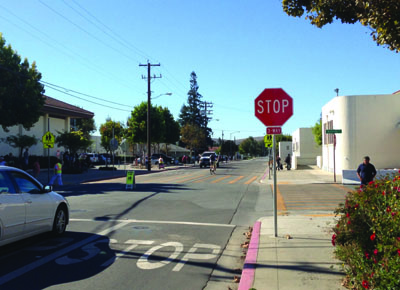After years of concerns over pedestrian safety near the high school, the city and county recently responded to those worries and installed stop signs at two Nash Road intersections.
Crews at the outset of last week installed stop signs at two intersections along Nash Road near the 3,000-student high school – at Monterey and West streets. Those installations came after approvals from the San Benito County Board of Supervisors and Hollister City Council following pleas from SBHS Trustee Ray Rodriguez, who spoke to officials at public meetings in April about the need for improvements.
Rodriguez at those meetings cited a consultant’s 2007 traffic study done near the high school and Nash Road. The study showed there were 11,000 crossings on school days and recommended that a temporary or permanent closure may be needed to ensure safe passage. Rodriguez in April also pointed out that school officials had broached the concern on multiple occasions, and with no action from government officials at the city, county or Council of San Benito County Governments.
The concern actually dates back about a decade, when the San Benito High School District finished an addition that was intended, at the time, as a freshmen transitional campus. Rodriguez has noted that school officials previously broached the concern on multiple occasions, while district officials in 2003 expressed safety concerns about growing pedestrian traffic and discussed such solutions as a pedestrian overpass, temporary closures during school hours and pedestrian signals.
The city and county, which maintain joint authority over Nash Road, decided on the stop signs as the appropriate approach and – despite five years going by – cited the study concluding 11,000 crossing occurred in that area during an average school day. Rodriguez when he spoke to government officials contended the study’s figures remained relevant because there was similar pedestrian traffic in that area.
David Rubcic, an engineering official with the city, explained that local governments had the two intersections converted from one-way stops to three-way stops. They installed an additional stop sign at a driveway leading into the campus, he said.
Although there are crossing guards during school hours, Rubcic stressed that drivers do need to stop at the intersections at all times.
“They do need to stop at the stop signs, even when the campus supervisors are being used as crossing guards,” Rubcic said of the area, where the speed limit is 35 mph and 25 mph in school zones.
Rubic said the stop signs are a proactive measure – he could not recall any major accidents at those intersections – and he believes they would improve safety. He did acknowledge that stop signs, when unwarranted, can cause unnecessary problems.
To curtail problems for drivers who may have been confused by the changes, the city had installed yellow signs alerting people about the pending changes before they occurred. The Hollister Police Department, meanwhile, was initially issuing warnings to drivers for stop sign violations there. While it was a courtesy at the outset, interim Police Chief David Westrick said officers do maintain the authority to cite drivers there and they would be doing so. He said Hollister officers generally give warnings for a week with new stop signs.
“We understand it takes a little while for people to get accustomed” to them,” he said in an email. “This however, doesn’t prevent the officer from writing a citation if the violation is particularly dangerous or serious.”
Rodriguez could not be reached immediately before press time.









